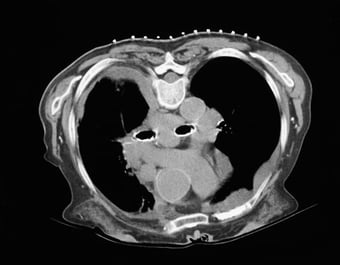 CT-guided needle biopsies play a crucial role in diagnosing a wide range of conditions, particularly in the lungs. But one of the most challenging parts of the procedure is getting the needle entry site just right. Between anatomical complexity, limited visibility, and the natural movement of patients, even experienced radiologists can face uncertainty when choosing where to begin.
CT-guided needle biopsies play a crucial role in diagnosing a wide range of conditions, particularly in the lungs. But one of the most challenging parts of the procedure is getting the needle entry site just right. Between anatomical complexity, limited visibility, and the natural movement of patients, even experienced radiologists can face uncertainty when choosing where to begin.
Why the Entry Site Is So Critical
A lot rides on that first pass. An off-target approach can lead to repeat scans, multiple needle insertions, and longer procedure times, in addition to discomfort for the patient and frustration for the care team. It’s no surprise that recent studies and technologies are focusing more than ever on improving how and where we plan that point of entry.
 Lesions can often sit deep in the lung tissue or close to sensitive structures, making them tricky to access. A 2025 study introduced virtual airway “heatmaps” to help guide radiologists to safer, more accurate biopsy paths. By mapping airways and lesion positioning, the tool made it easier to visualize the best entry sites, and results showed a clear improvement in sample quality and safety.
Lesions can often sit deep in the lung tissue or close to sensitive structures, making them tricky to access. A 2025 study introduced virtual airway “heatmaps” to help guide radiologists to safer, more accurate biopsy paths. By mapping airways and lesion positioning, the tool made it easier to visualize the best entry sites, and results showed a clear improvement in sample quality and safety.
The challenge, though, is that most imaging still relies on static CT slices, which don’t always capture the full three-dimensional picture of a moving, breathing patient. This makes it hard to reliably match the skin mark to the internal target. What looks like the right spot in theory might shift slightly in practice, resulting in missed targets, re-scans, or re-sticks.
What’s Being Done to Improve Accuracy
There’s been a lot of exciting innovations aimed at solving this problem. A 2023 study highlighted a robotic biopsy system that offered trajectory guidance along with haptic feedback. Essentially allowing the operator to “feel” their way through tissue layers for more precise needle control.
Another team, in a 2020 preclinical trial, explored using augmented reality with a HoloLens headset to help visualize needle paths more clearly. It significantly reduced the number of passes needed and lowered radiation exposure. More recently, researchers introduced a system that combines cone-beam CT and ultrasound to give a more complete picture of the biopsy site.
These technologies are impressive and promising for the future, but they also come with added cost, complexity, and training requirements. That’s where a simpler, more accessible solution can make a big impact right now.
A Practical Tool for Everyday Use: GuideLines® Biopsy Grids
GuideLines® CT biopsy grids are designed to take the guesswork out of localizing the needle entry site. These disposable, radiolucent grids provide a high-contrast visual reference that appears on both the patient’s skin and the CT monitor, helping to ensure accurate alignment throughout the procedure.

What makes GuideLines® so effective is its simplicity. By placing the grid directly on the patient, you get a consistent point of reference that doesn’t shift if the patient moves slightly or if the scan has to be paused. This helps reduce variability between planning and execution, making it easier to get the right spot the first time.
Radiologists using GuideLines® often report fewer needle passes, fewer rescans, and shorter procedures overall. That’s good news for workflow, patient comfort, and diagnostic confidence.
Why First-Stick Accuracy Matters for Your Team
 Improving first-stick accuracy doesn’t just help patients; it helps the entire care team. Less time spent repositioning means more efficient use of the scanner. Fewer re-sticks mean less stress for technologists and better outcomes for radiologists.
Improving first-stick accuracy doesn’t just help patients; it helps the entire care team. Less time spent repositioning means more efficient use of the scanner. Fewer re-sticks mean less stress for technologists and better outcomes for radiologists.
With healthcare systems under pressure to do more with less, tools that improve accuracy without adding cost or complexity are worth paying attention to.
GuideLines® integrates seamlessly into your current workflow: no software, no setup, no special training required. It’s an easy win for departments looking to standardize their approach to CT-guided biopsies.
If you're looking to boost confidence in entry point localization and reduce the number of needle passes during CT-guided biopsies, it may be time to give GuideLines® a try.
Beekley Medical offers trial evaluations so you can see how GuideLines® biopsy grids compare to your current method. To learn more or to request samples for a trial evaluation, contact your Beekley Medical Imaging Account Manager at 1-800-233-5539, or email info@beekley.com.
Related articles:

Jonathan McCullough
Product Manager
